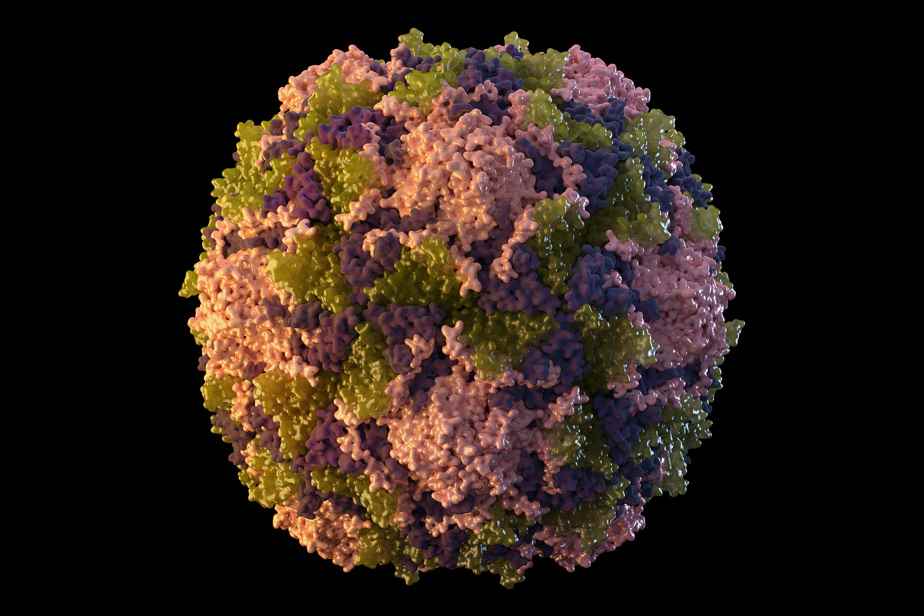The polio virus, eradicated in most countries for several decades and capable of causing paralysis, was detected in sewage in New York and London over the summer. Faced with these new cases, Health Canada announces that it wants to test wastewater in the country and insists on the need to be vaccinated.
Posted at 8:00 a.m.
Test wastewater “as soon as possible”
“While the overall risk of polio to Canadians remains low, these international cases are a good reminder to stay current on vaccinations, even for rare vaccine-preventable diseases,” The Press Public Health Agency of Canada spokesperson Andréa Richer.
In New York, a person was paralyzed a few weeks ago due to a polio infection in the city’s north end. Sewage samples taken in June in his county contained the virus. In addition, traces of the poliovirus have been found in sewage in London, but no cases of polio have yet been detected in the population.
Faced with these international cases, Health Canada has announced that it will begin “as soon as possible” to test the wastewater of a certain number of Canadian cities.
A risk that the disease “reappears”
Thanks to vaccination, Canada has been polio-free since 1994. However, health authorities warn that there is “a risk that polio will reappear” since it is still rife in other countries, such as Afghanistan and Pakistan. “For example, a person infected with poliomyelitis in another country could travel to Canada and infect people who are not immune,” said the Health Canada spokesperson.

PHOTO RENÉ PICARD, LA PRESSE ARCHIVES
Quebec schoolboy receiving a dose of polio vaccine, 1963
very contagious
This highly contagious disease spreads in the feces of an infected person. The virus enters the body through the mouth, mainly through food or water contaminated with feces.

PHOTO YURI CORTEZ, FRANCE-PRESSE AGENCY
A child receives a dose of oral polio vaccine in Caracas, Venezuela.
Possible paralysis
Although most people infected with the polio virus have no visible symptoms, a small fraction of those affected contract a more serious illness: acute paralytic poliomyelitis. This disease attacks the central nervous system and can lead to paralysis and even death.
In general, the paralysis improves after a few years, but many people remain affected by significant weakness. Of these patients, a large proportion will also develop post-poliomyelitis syndrome 30 to 40 years after illness.

PHOTO PROVIDED BY THE DD DARIA TROJAN
The DD Daria Trojan, professor of neurology and neurosurgery at McGill University and specialist in post-polio syndrome
“The two main symptoms of the syndrome are muscle weakness and/or progressive muscle fatigue,” says Dr.D Daria Trojan, professor of neurology and neurosurgery at McGill University and specialist in post-polio syndrome. Some patients may also have trouble breathing and swallowing.
Look for his five doses
There is no cure for acute polio or post-polio syndrome, says DD Trojans. Vaccination is therefore the best way to protect children. In Canada, it is recommended that children be vaccinated four times at a young age, at 2, 4, 6 and 18 months, and receive a booster shot between 4 and 6 years of age.

PHOTO ED JONES, AGENCE FRANCE-PRESSE ARCHIVES
Poliovirus vaccine box administered at a clinic in Brooklyn
The importance of vaccination
The poliovirus detected in New York and London is derived from a vaccine strain. Although rare, this form of the virus has become more common in recent years due to low vaccination rates in some communities.
In Canada, the vaccine administered is based on inactivated virus. On the other hand, many countries around the world, such as Afghanistan and Pakistan, rather administer the oral vaccine, which contains the weakened live virus, indicates Alain Lamarre, professor-researcher specialized in immunology and virology at the National Institute of scientific research (INRS). This vaccine offers many advantages, in particular by facilitating its administration.

PHOTO RIZWAN TABASSUM, AGENCE FRANCE-PRESSE ARCHIVES
A caregiver administers a polio vaccine to children in Karachi, Pakistan.
However, in communities with low vaccination rates, the attenuated virus contained in the vaccine can spread from one unvaccinated child to another, mutate and eventually revert to a form that could lead to paralysis, the Initiative warns. world for the eradication of poliomyelitis.
Some numbers
5 years
Poliomyelitis mainly affects children under 5 years old. However, anyone who has not been vaccinated can contract the disease, regardless of age.
Source: World Health Organization (WHO)
0.5%
One in 200 infections results in irreversible paralysis, usually of the legs.
Source: WHO
86.4%
Proportion of 7-year-old children who have received all five doses of poliomyelitis vaccine in Quebec
Source: National Institute of Public Health of Quebec (INSPQ)
Major polio epidemics in Quebec

PHOTO PAUL-HENRI TALBOT, LA PRESSE ARCHIVES
People line up outside Montreal City Hall to receive a dose of polio vaccine, 1959.
- 1916 – A poliomyelitis epidemic causes 109 cases in Montreal.
- 1931 – Over 70 people die in an outbreak of 744 cases.
- 1946 – An epidemic of 684 cases causes about thirty deaths.
- 1959 – A new poliomyelitis epidemic begins at the end of April. In total, 1039 cases are reported, including 934 in Montreal.
Source: INSPQ

